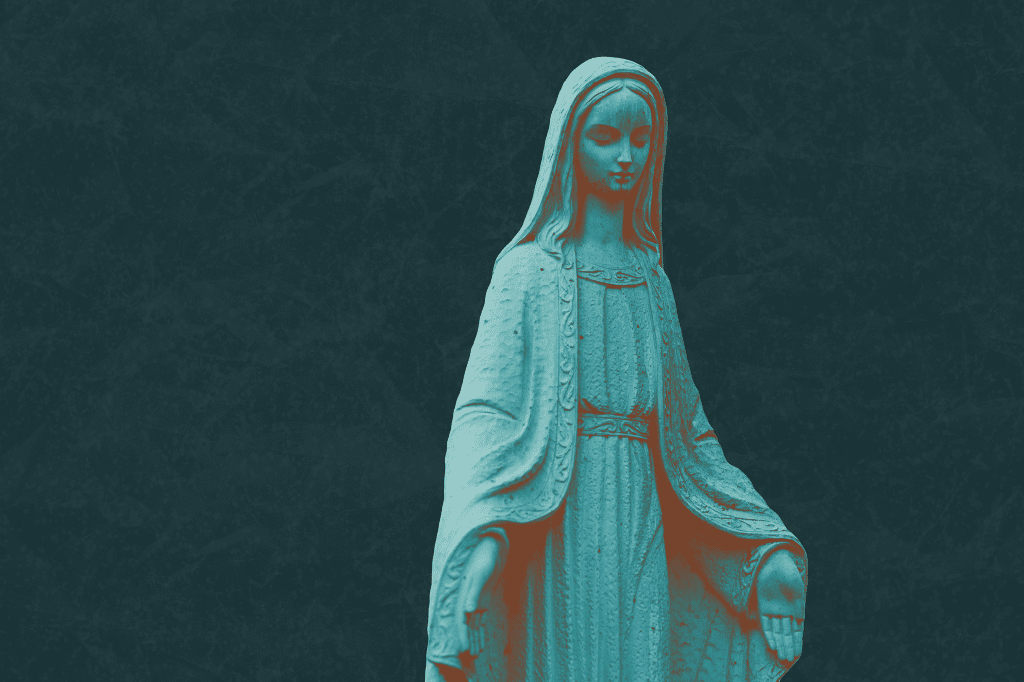All for Jesus, all through Mary.
John the Evangelist portrays Mary in unique ways at the beginning and end of the Gospel. In Chapter Two, we are invited to the wedding feast at Cana, where Mary, after discovering that the wine had run out, approaches her son Jesus to intercede on behalf of the wedding party. In her final words recorded in the Gospel, the Mother of Jesus tells the servers the advice that continually echoes in the ears of every servant of Jesus: “Do whatever he tells you.” (Jn 2:5) Near the end of the Gospel, we meet the Mother of Jesus at the foot of the cross, where Jesus entrusts her to future generations of Christians as our Mother. She becomes the model for all who unite their sufferings with Jesus’s sufferings: her Immaculate Heart breaks as Jesus’ Sacred Heart is pierced. From the beginning to the end of the Gospel, and throughout the lives of joyful, missionary disciples who have heard the proclamation of the Good News, Mary intercedes, gives comfort and brings us to her son Jesus.
Because of the inseparable relationship of love between Jesus and his mother, the Church recommends to the faithful the spiritual benefit of uniting ourselves closely with Mary. If God the Father entrusted his son to Mary to bring Jesus into the world through the Incarnation, so, too, will Jesus come to life in us when we entrust ourselves to Mary.
One way that disciples experience this mystery of union with Jesus through friendship with Mary is in the various forms of Marian consecration. To consecrate something or someone is to set it apart for a holy purpose. Being set apart through consecration is not about withdrawal or inaccessibility; rather, it is about nearness and union with God. We consecrate our lives to Jesus and seek to do God’s will by entrusting ourselves to Mary, who knows Jesus and what it means to do God’s will better than anyone. The Church and the saints consider this act to be consecration to Jesus through Mary, but we sometimes refer to it as Marian consecration or Marian entrustment as a sort of shorthand.
Queen of All Saints, Pray for Us
Many saints have written and reflected on the role of Mary in the lives of her son’s disciples, but the classic example of consecration to Jesus through Mary comes from St. Louis de Montfort (1673–1716). St. Louis encouraged people to spend 33 days in preparation before making an act of consecration. All the instructions and prayers for the consecration are found in his book True Devotion to Mary. The first 12 days are spent emptying oneself of the spirit of the world and praying for an outpouring of Jesus’s spirit — the Holy Spirit. Then, the following three weeks have their own particular intentions: first, to gain knowledge of self and sorrow for sin; second, to understand Mary’s role and the Holy Spirit’s gifts; finally, to know and understand Jesus. St. Louis’s model of consecration involves praying litanies (especially the Litany of Loreto and the Litany of the Holy Spirit) throughout the time of preparation. At the end of the 33 days, one makes a good confession, receives holy Communion and makes the act of consecration that St. Louis provides.
Queen of the Most Holy Rosary, Pray for Us
Pope St. John Paul II was deeply dedicated to Our Blessed Mother and fostered devotion to her through the recitation of the rosary. Whether the pope was praying the traditional joyful, sorrowful or glorious mysteries, or the modern luminous mysteries (which he gave as a gift to the Church), John Paul knew no better way to view Our Lord’s life than through the lens of Our Lady. The rosary beads become links in a chain that connects us through the heart of Our Lady to the heart of Our Lord. Pope St. John Paul II entrusted his entire life, priesthood and service in the Church to Our Lady with words that he borrowed from St. Louis de Montfort: Totus tuus, (totally yours).
Morning Star, Pray for Us
Father Michael Gaitley, a priest with the Marians of the Immaculate Conception, builds upon St. Louis de Montfort’s model of 33 days of preparation in his outstanding book 33 Days to Morning Glory. Father Gaitley offers daily reflections and prayers for the experience of a do-it-yourself retreat. Ideally, the 33 days would be spent with others: family members, friends, co-workers, members of your family of parishes, school and pastoral staff and leadership teams. Throughout the 33 days, Father Gaitley provides the participants with four examples from the lives of the saints who entrusted themselves to Mary: Sts. Louis de Montfort, Maximilian Kolbe, Teresa of Calcutta and John Paul II. Father Gaitley’s writing is accessible and interesting, and his reflections and questions will lead to fruitful discussions and prayer times for the participants.
Virgin Most Faithful, Pray for Us
Marian consecration is a model for deeper union with Jesus because Mary is the model of a disciple who is perfectly consecrated to Jesus. But who is a model of Marian consecration? Why, St. Joseph, of course! In marriage, when Joseph was consecrated to Mary, he was set apart by God for a holy purpose: to care for and provide for Our Lord and Our Lady. This was no small task. It required an immense amount of grace on God’s part and strength on Joseph’s part. As husband and father in the Holy Family, Joseph was as close as one could be to heaven on earth. In this year that is dedicated to St. Joseph, perhaps the best example of Marian consecration is this traditional prayer: All for Jesus, all through Mary, in imitation of good St. Joseph.
